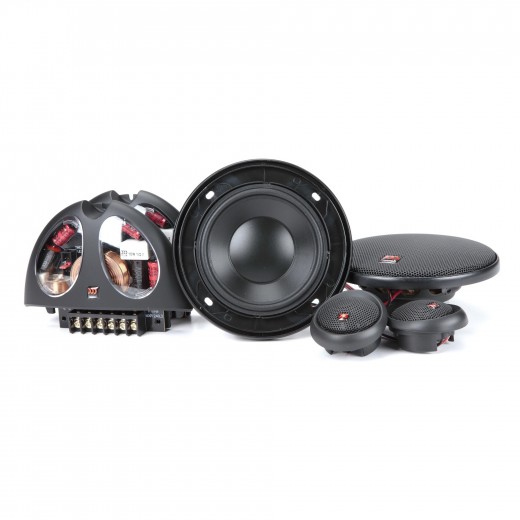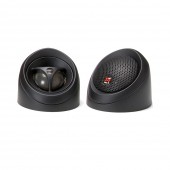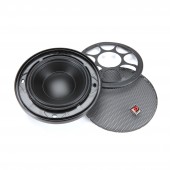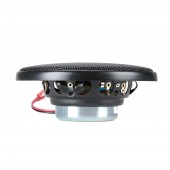Morel Hybrid 402 speakers
Ø 104 mm, 100/300 W, 4 Ω, 89 dB (2.83V/1m), installation depth 50 mm
More about the product
More about the product
We will help you with your purchase
- Use our consulting room
- You can return the goods to us within 14 days
- Try the product at our store
Morel Hybrid 402 2-way component speakers
The speakers of the Hybrid model series are often rightly referred to as some of the best speakers ever produced by Morel. Their latest generation is one step closer to perfection. The new Hybrids include an innovative magnetic system and several patented technologies such as the Hexatech™ coil in the EVC™ structure, the CAR filter that improves acoustics by controlling the air flow inside the driver, or the aerodynamic design of the Uniflow™ basket. The mid-bass is complemented by the almost legendary and innovative MT230 tweeters with extraordinary sound and equally high-quality MXR240.3 crossovers..jpg)
- 2-way component speakers
- One-piece DPC membrane
- Hexatech™ aluminum coil
- EVC™ structure
- 28mm Acuflex™ tweeter
- Hybrid magnetic motor
- Shielded magnet
- MXR Direct Crossover
- CAR Filter™
- Uniflow™ speaker basket
- Design grid included
- Reduction to 165 mm in the package
- Extra large 2" voice coil
Hybrid MW4 mid-bass speaker
The heart of the new Morel mid-bass loudspeakers of the Hybrid model series is the unconventional, innovative and highly efficient Hybrid magnetic system. The mid-bass speakers feature advanced technologies such as a one-piece DPC diaphragm, a large 2.1" (54 mm) Hexatech™ voice coil in an EVC™ structure, a CAR filter that improves acoustics by controlling the airflow inside the driver, resulting in a 30% increase in performance over the previous The aerodynamic design of the aluminum die-cast Uniflow™ basket minimizes sound distortion and increases the overall performance of the speaker.Tweeter Morel MT230
Brand new tweeters with Morel's typical "sweet and warm" sound, powerful double neodymium magnet and Acuflex™ silk dome. The speakers feature a 28 mm (1⅛") Hexatech™ aluminum voice coil, which together with the double magnet provides even better performance and low resonance. The Morel MT230 are a great choice for anyone who expects crystal clear and precise sound with endless dynamics.Morel Hybrid MXR240.3 crossovers
The unconventionally designed Morel Hybrid MXR240.3 crossovers are made to provide near-perfect phase control and consistent transition between individual components. They combine several new concepts and functions that, together with top-quality materials, improve audio presentation and sound quality.| Catalog number | HYBRID 402 |
| Brand | Morel |
| Links | Official web presentation |
| Speaker typeCoaxial speakers: Coaxial speakers are characterized by a so-called all-in-one design. The tweeter and mid-bass speaker are in one basket. The advantage is simpler assembly, but thanks to the connection or proximity of the bands in one speaker, the sound quality will usually be reduced. As a rule, in the middle of the mid-bass speaker, there is a tweeter whose voice coil works in the second air gap of the common magnetic circuit. The three-way coaxial speaker consists of a mid-bass speaker, a center speaker and a separate tweeter in the front on a special beam. Component Speakers: Component speakers are characterized by a division into individual frequency bands, treble + mid-bass + or. bass band. The individual speakers can be placed completely separately, which results in a better sound and acoustic performance. In the vast majority of cases of component speakers, an external crossover is also supplied, which divides the treble, middle / mid-bass, and into the three-band the bass band or allows setting the decibel level of the tweeter (e.g. +2 dB, 0 dB, -2 dB), steepness (e.g. 6dB/Oct. 12dB/Oct.) or active or bi-amp connection. | Komponentní 2pásmové |
| RMS powerRMS speaker power is the constant power of the entire system, not just one speaker or one side. This is also the performance of continuous use of the speakers. If the RMS power is exceeded for a long time, the speakers may be irreversibly damaged! | 100 W |
| Max. (maximum performancePeak performance , which the speaker can play for a moment (approx. 0.5 s), for example when hitting drums in a song. If the max power is exceeded, the speakers will usually be damaged! | 300 W |
| Sensitivity (SPL 2.83V/1m)Sensitivity, sensitivity or efficiency of the speaker. Speaker sensitivity is given in decibels (dB) and simply put, the higher the value, the lower the demands on the amplifier's power. This is a defacto rating of how a speaker converts watts to sound. Sensitivity ratings are in noise level measured at 1 meter from the speaker using 1 W (watt of power) or using 2.83 volts at the source at 1 meter. A higher decibel level means the speaker is louder with less power. For every 3 dB increase in sensitivity, the speaker requires half the power to reproduce the same volume. For example, if an 88 dB speaker needs 100 Watts to produce a certain volume, then a speaker with a sensitivity of 91 dB needs only 50 Watts to reach the same volume. | 89 dB |
| ImpedanceImpedance - measurement of electrical resistance. When buying speakers, it is important to make sure that the impedance matches the amplifier or car stereo you are using. Example: A 2 Ohm speaker cannot be connected to an amplifier that is only stable up to 4 Ohms! A 4 Ohm speaker can easily be used with an amplifier that is stable up to 2 Ohms. The most common speaker impedance today is 3 - 4 Ohm. | 4 Ω |
| Frequency rangeThe ability of the speakers to play a signal from the lowest frequency to the highest, or the speaker's ability to faithfully reproduce sound in a specific frequency band. Professionally: In the frequency range from 40 to 16,000 Hz, the vast majority of fundamental and overtones (harmonics) of all musical instruments are found. We are interested in the course of the radiated sound pressure in this range of frequencies when the loudspeaker system is supplied with constant power. We call this course the frequency characteristic, which tells us the level of radiated sound pressure in decibels (dB) depending on the frequency. The frequency characteristic of a speaker or speaker system can be expressed most succinctly with a graph. Mostly, however, the frequency characteristic is indicated by indicating the maximum tolerance of the sound pressure in the given frequency range, e.g. 50 to 15,000 Hz -+ 6 dB. Since the frequency characteristics of loudspeakers and systems in general are quite uneven, some manufacturers do not even specify this maximum tolerance of sound pressure in decibels in their catalogs for reasons of prestige. Data impoverished in this way is unfortunately worthless. What is valid is that the manufacturer offers a speaker system with a frequency range of 30 to 20,000 Hz, if he is worried about stating the maximum unevenness of the sound pressure in this range, because he can have a tolerance of, for example, +- 20 dB. The unevenness or undulation of the frequency curve in good speaker systems for high-quality music performance should not exceed +-3 dB in the 80 to 12,000 Hz band and +-6 dB in the 40 to 16,000 Hz band. Greater unevenness already depletes or emphasizes certain tonal areas, which can cause audible or even disturbing distortion. The proportion between fundamental tones and higher harmonics also changes, thereby changing the color of the sound, and individual musical instruments as well as the entire musical image sound unnatural. | 70 - 25000 Hz |
| The diameter of the mid-bass speakerWe state the diameter of the speaker as the diameter of the entire speaker, not including the mounts, when smaller speakers (87, 100, 130 mm) have extra mounts. Some speakers are oval and there the dimension is given in inches, always the shortest side to the longest side. One inch is approx. 2.5 cm. | 104 mm |
| Installation depth of the mid-bass speakerThe installation depth of the speaker is measured from the bottom edge of the magnet to the bottom edge of the tin, plastic or cast speaker basket, or speaker bearing surfaces. | 50 mm |
| Overall tweeter diameterThe total diameter of the tweeter is given as the diameter of the individual tweeter without the installation houses. | 45 mm |
| Tweeter dome diameterThe net diameter of the dome (diaphragm) of the tweeter. | 28 mm |
| The overall depth of the tweeterThe total depth of the tweeter itself without the installation houses. | 50 mm |
| Tweeter dome materialThe shell material that was used in the manufacture of the tweeter. | Hedvábí |
| Frequency crossover included in the packageThe crossover is an important part of defacto all loudspeakers. A crossover usually contains different resistor values, coil sizes, and capacitor types that fundamentally modify the sound. We describe below what the turnouts are for. Component Speakers: A crossover is part of every quality component speaker system. Its task is to ensure the distribution of frequencies that the amplifier produces in the entire acoustic spectrum of frequencies so that each of the speakers receives only that part of the band that it can optimally play in terms of efficiency and minimal distortion. Coaxial speakers: In most cases, coaxial loudspeakers have a simple crossover (6dB/Oct.) formed by a capacitor at the tweeter. | Ano (plnohodnotná) |
| Options for setting the frequency crossoverThe unwritten rule is that the more expensive the speakers, the more options the crossover has for adjusting the sound. The most common way to adjust the crossover is attenuation on the tweeter. More advanced crossovers also offer the option of setting the steepness on the mid-bass and tweeter or adjusting the frequency range. | Ano (Tweeter +/-2 dB) |
| Cover grids included in the packageOriginal cover grilles in speaker packaging. | Ano |
| Other | Hybridní magnet |
| Price forIf the price is for a pair, the package always includes 2 pieces of everything, e.g. 2x mid-bass, 2x tweeter and 2x crossover. | Pár |
Product comments
Evaluation
Product assembly
ask us






